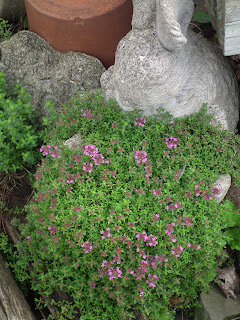Tea Zen...
Another moody, broody day in Ohio. Surviving the dreary, wet days here takes some creativity on the part of those of us who suffer from SAD (seasonal effective disorder). During such seasons tea becomes a magic elixir of warm comfort that helps to carry me through the le heure blue of winter. (Le heure blue is the time after sunset when the overall lighting renders everything a dark blue before the darkness of night sets in.) The good news about snow is that it reflects light and, at least for a while, it turns the world into a lacy, bright fairyland. Even the night is lighten with a covering of snow. Sorry, but we don't have much of that this year. Everything is wet, muddy, and cold, though not freezing. The soggy dreariness takes its toll on everyone. Nearly everyone you talk to is grouchy and negative, which is a clear symptom of SAD. Tea and candles become necessary tools of survival. Having a bit of chocolate couldn't hurt anything, too!
It would seem that nearly anything can be steeped in hot water to create tea of a kind. Actually, some teas are really tisanes. Hercule Poirot, Agatha Christie's famous detective, was known for ordering lemon tisane while others around him were ordering up a stiff cuppa, or even strong coffee. So, just what is the difference between tea and tisane? Tea is the dried leaves of the thea, (camellia sinensis plant) infused in bowling water. Tisane is a decoction of herbs in boiling water. Tisane is often used for medicinal reasons, though it is now more understood that tea also has medicinal and health properties. Tea may contain caffine and tannic acid. Tisane usually is milder and does not have caffine or tannic acid. Whichever you decide to use, the dreary grey days of winter can go a bit better with that sweet bit of liquid Zen.
One of my greatest treats was that of a brewed pot of lemon balm leaves with an added bit of lemon verbena. Neither of these herbs are readily growing in Ohio during the winter, but my window garden area has some sweet pots of these delightful plants. With a little honey to sweeten the pot, I have a bit of liquid gold in a cup that makes me feel as though I'd had a vacation to some wonderful warm bit of herb heaven. Me SAD no more! Silly, but hey, whatever it takes to get you through until spring. So, endulge yourself, pamper yourself, and soon it will be spring. Such a civilized way to keep away the winter blues!
It would seem that nearly anything can be steeped in hot water to create tea of a kind. Actually, some teas are really tisanes. Hercule Poirot, Agatha Christie's famous detective, was known for ordering lemon tisane while others around him were ordering up a stiff cuppa, or even strong coffee. So, just what is the difference between tea and tisane? Tea is the dried leaves of the thea, (camellia sinensis plant) infused in bowling water. Tisane is a decoction of herbs in boiling water. Tisane is often used for medicinal reasons, though it is now more understood that tea also has medicinal and health properties. Tea may contain caffine and tannic acid. Tisane usually is milder and does not have caffine or tannic acid. Whichever you decide to use, the dreary grey days of winter can go a bit better with that sweet bit of liquid Zen.
One of my greatest treats was that of a brewed pot of lemon balm leaves with an added bit of lemon verbena. Neither of these herbs are readily growing in Ohio during the winter, but my window garden area has some sweet pots of these delightful plants. With a little honey to sweeten the pot, I have a bit of liquid gold in a cup that makes me feel as though I'd had a vacation to some wonderful warm bit of herb heaven. Me SAD no more! Silly, but hey, whatever it takes to get you through until spring. So, endulge yourself, pamper yourself, and soon it will be spring. Such a civilized way to keep away the winter blues!



Comments
Post a Comment